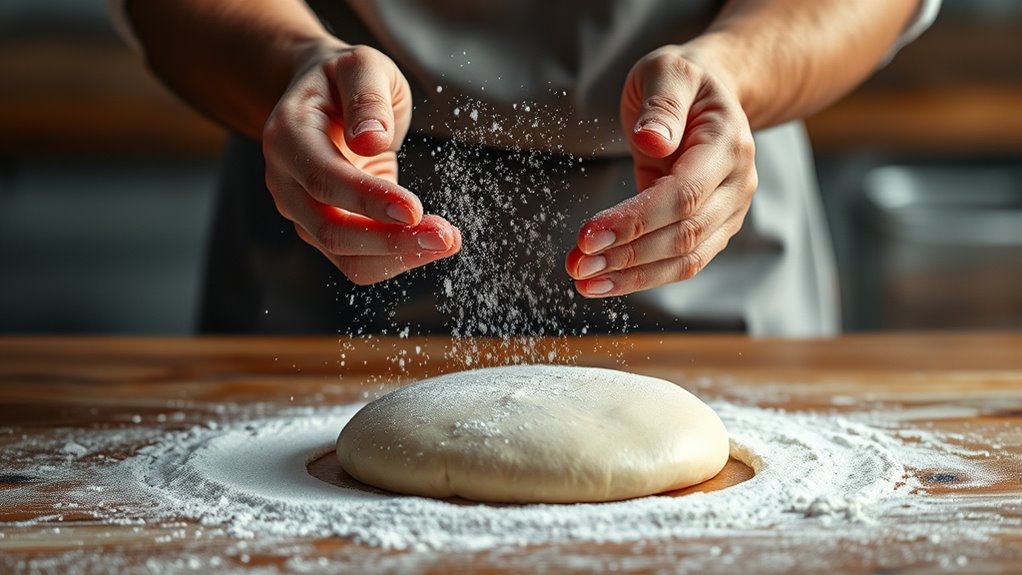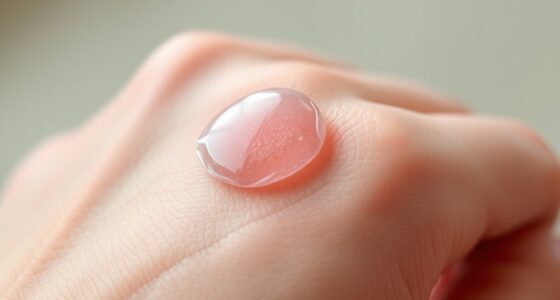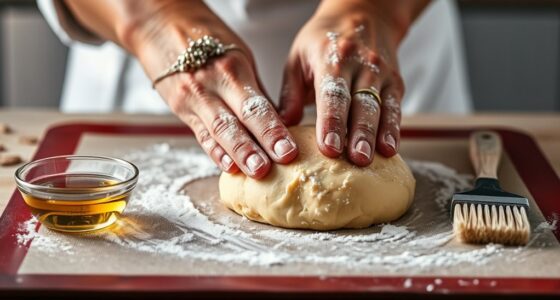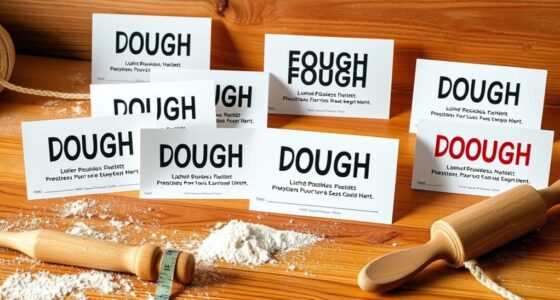To prevent dough from sticking, start with the right flour like bread flour to develop gluten and choose a work surface and tools lightly dusted with flour. Gradually add flour during mixing and rolling to control moisture, and keep your hands damp for better handling. Incorporate fats like butter or oil to reduce stickiness, chill your dough for easier shaping, and use parchment paper or non-stick surfaces. Keep exploring for more tips to master your dough!
Key Takeaways
- Use high-protein flours like bread flour to improve gluten development and reduce stickiness.
- Lightly flour work surfaces and tools to prevent dough from sticking during handling and shaping.
- Gradually add flour during mixing and rolling to maintain optimal dough hydration and manage stickiness.
- Keep hands and dough slightly damp or floured to ease handling of sticky dough.
- Incorporate fats like butter or oil to coat flour particles, reducing stickiness and improving dough manageability.
Choosing the Right Flour for Less Stickiness
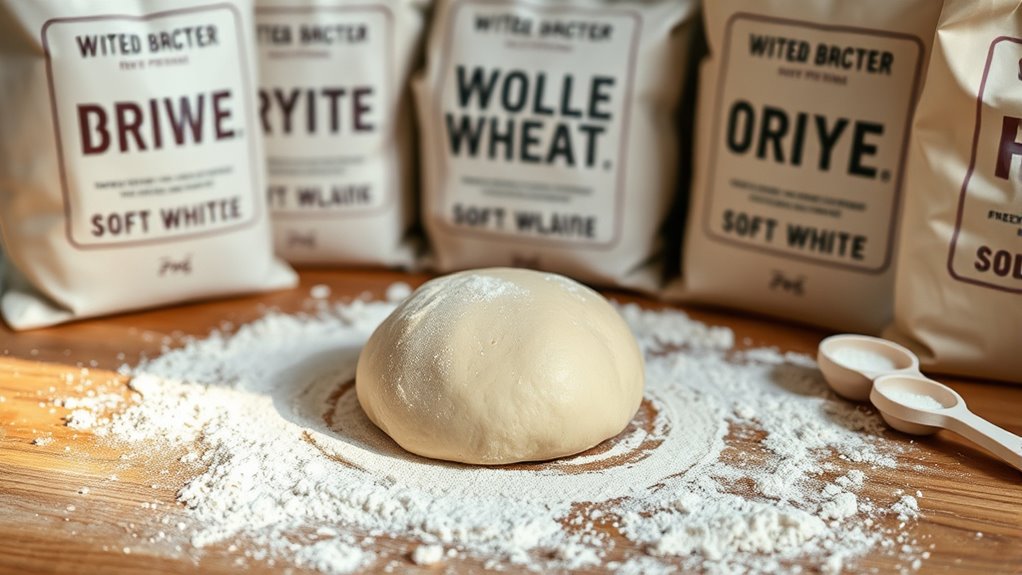
Choosing the right flour is essential if you want to keep your dough from sticking. The type of flour you use impacts gluten development, which influences the dough’s elasticity and smoothness. High-protein flours, like bread flour, create stronger gluten networks, making the dough less sticky and easier to handle. Proper gluten development also supports a better fermentation process, allowing yeast to produce carbon dioxide efficiently, which helps the dough rise evenly. If your flour has too little protein, your dough might be sticky and difficult to shape. Conversely, too much gluten can make it tough. Selecting a flour with the right protein content guarantees your dough is manageable and develops the ideal structure during fermentation, reducing stickiness and improving overall texture. gluten development plays a crucial role in achieving the perfect dough consistency.
Properly Preparing Your Work Surface and Equipment

To prevent your dough from sticking, it is crucial to properly prepare your work surface and equipment before you start kneading or shaping. Lightly dust your work surface with flour, considering the dough’s hydration level—more hydrated dough may need a bit more flour to prevent sticking. Use a clean, smooth surface like a marble or wooden countertop, which helps maintain even gluten development and reduces sticking. When handling your tools, lightly flour your rolling pin or bench scraper to avoid sticking during shaping. Keep your hands slightly floured as well. Properly preparing your equipment ensures the dough won’t stick excessively, making it easier to work with and encouraging good gluten development for better texture. Additionally, selecting the appropriate headphone jack can improve your audio experience when working on related tasks. This setup helps you achieve smooth, well-shaped dough every time.
Using the Correct Amount of Flour During Mixing and Rolling
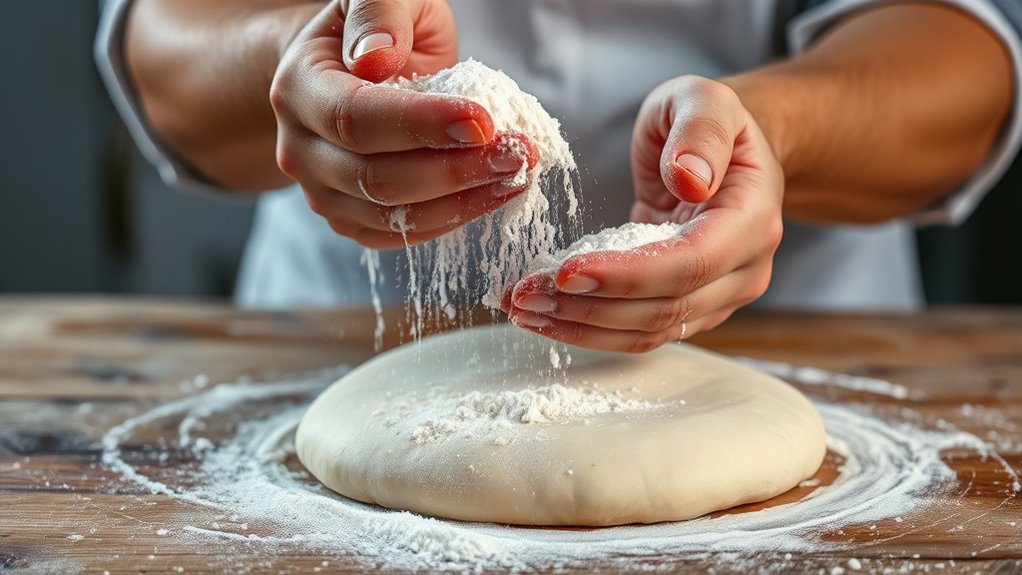
Using the correct amount of flour during mixing and rolling is essential to prevent sticking and achieve the desired dough consistency. Too much flour can make your dough dry and tough, while too little impairs dough hydration, making it sticky. Properly balancing flour helps control dough hydration, ensuring it’s supple but not overly sticky. This balance also influences gluten development; enough flour promotes ideal gluten formation for elasticity and structure. When you add flour gradually, you can better gauge the dough’s texture and prevent over-flouring. During rolling, dust your surface and rolling pin with a light coating of flour — not excess — to keep the dough from sticking without compromising its hydration or gluten network. Precision in flour use ensures smooth handling and a better final result. Monitoring the patterns in angel numbers can also provide additional insights into timing and harmony during baking.
Techniques for Handling Sticky Dough Without Frustration

Handling sticky dough can be challenging, but with the right techniques, you can work with it smoothly and confidently. To prevent frustration, focus on managing hydration levels and supporting gluten development. Here are three key strategies:
- Use a Bench Scraper: Lightly dust it with flour to lift and fold dough without sticking.
- Keep Hands Damp: Slightly wet your hands to prevent sticking while shaping or folding.
- Adjust Hydration Gradually: If dough remains too sticky, slightly reduce water in your recipe to improve handling and gluten structure.
These methods help you control stickiness, improve gluten development, and make kneading easier. Remember, patience and small adjustments are key to mastering sticky dough. With practice, you’ll handle it confidently and produce perfect results every time.
Incorporating Fats and Oils to Reduce Dough Stickiness
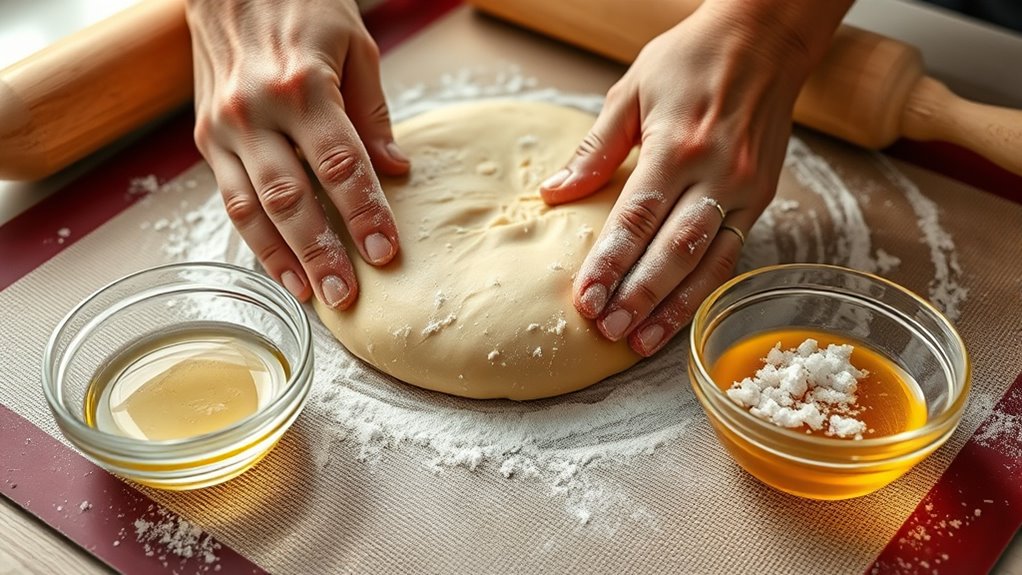
Incorporating fats and oils into your dough is an effective way to reduce stickiness and improve its workability. You can add butter substitutes or dairy additions like milk or yogurt to achieve a smoother, less sticky dough. These fats coat the flour particles, preventing excessive gluten development that causes stickiness. Use small amounts gradually to avoid altering the dough’s texture or flavor. Additionally, choosing the right decorative elements can enhance the overall aesthetics of your farmhouse bedroom.
Chilling Your Dough to Improve Manageability
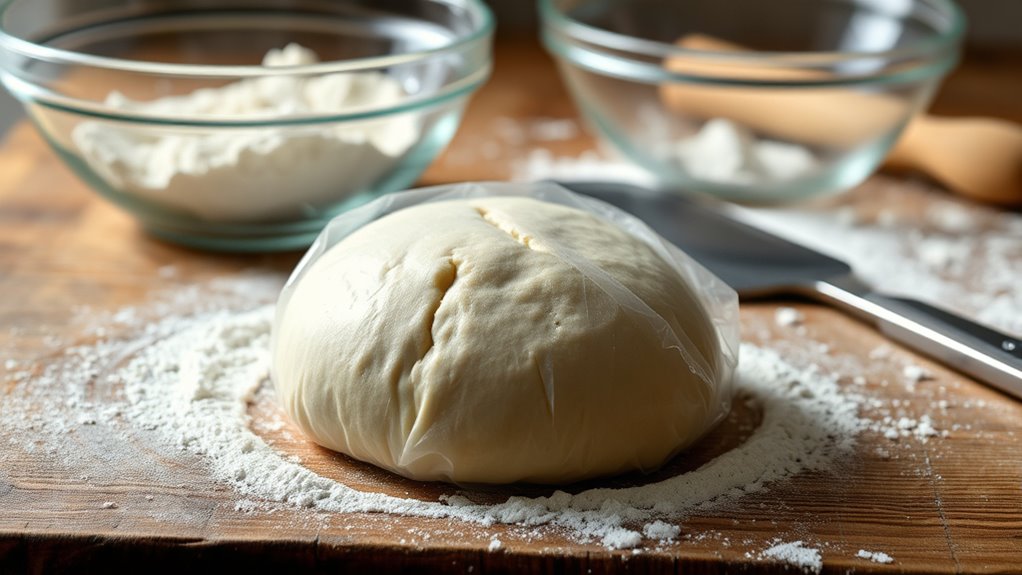
Chilling your dough is a simple yet effective way to make it more manageable and easier to work with. Lowering the dough temperature during a resting period firms it up, reducing stickiness and improving texture. This process allows the gluten to relax, making rolling and shaping smoother.
Chilling dough firms it up, reduces stickiness, and relaxes gluten for easier shaping.
Here are three tips to optimize this method:
- Wrap the dough tightly to prevent it from drying out during the resting period.
- Chill for at least 30 minutes, or longer for better manageability.
- Use the cold dough directly from the fridge to reduce stickiness and improve handling.
Utilizing Parchment Paper and Non-Stick Surfaces Effectively
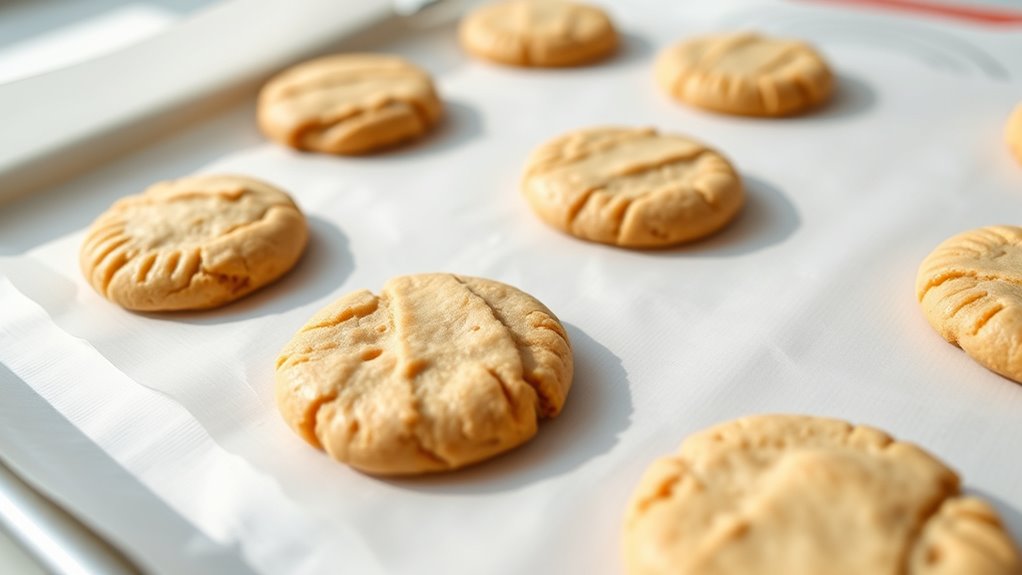
Using parchment paper and non-stick surfaces can markedly reduce the chances of dough sticking, making your baking process smoother. Proper dough hydration is essential—if your dough is too dry, it’s more prone to sticking; if too wet, it may become difficult to handle. Using parchment paper creates a barrier that prevents sticking regardless of dough consistency, especially when you make ingredient substitutions that alter moisture levels. Non-stick mats and silicone baking sheets are excellent options for maintaining a clean surface. These surfaces also help maintain consistent dough texture, reducing the need for excess flour or oil, which can change ingredient ratios. Additionally, contrast ratio plays a role in visual clarity, similar to how choosing the right non-stick surface affects baking results. By choosing the right surface and adjusting dough hydration, you guarantee easier handling and cleaner removal, leading to more successful baking results.
Frequently Asked Questions
Can Different Types of Flour Affect Dough Stickiness?
Yes, different types of flour can affect dough stickiness because of variations in gluten development and flour hydration. High-protein flours, like bread flour, develop more gluten, making the dough less sticky. Conversely, lower-protein flours, like cake flour, absorb less water and produce stickier dough. Adjusting hydration levels helps control stickiness, so choosing the right flour type and managing hydration are key for a smoother dough.
How Does Humidity Influence Dough Sticking Issues?
When humidity levels rise, dough tends to become stickier because it absorbs moisture from the air. To keep it in check, focus on humidity control in your environment and adjust your flour or water accordingly. Remember, too much moisture can turn your dough into a sticky mess, so monitor conditions closely. Handle the dough with floured hands or surfaces to prevent sticking, and you’ll stay ahead of the game.
Are There Natural Remedies to Reduce Dough Stickiness?
Yes, natural remedies can help reduce dough stickiness. You can improve gluten development by adding a small amount of essential wheat gluten, which strengthens the dough’s structure. Additionally, natural enzymes from ingredients like honey or apple cider vinegar enhance enzyme activity, breaking down sticky starches. Kneading the dough thoroughly also promotes gluten development, making it less sticky. These simple methods help manage stickiness without artificial additives.
What Tools Are Best for Handling Sticky Dough?
You should use a lightly floured silicone spatula or dough scraper to handle sticky dough comfortably. These tools help maintain the dough’s texture without adding too much flour, which can alter the baking temperature and results. Also, keep your hands and work surface well-floured to prevent sticking. Adjust the flour amount based on the dough’s stickiness, and guarantee your baking temperature is correct for ideal texture and easy handling.
How Does Overworking Dough Impact Its Stickiness?
Overworking dough is like stirring a pot too much—gluten development gets out of control. When you knead excessively, the dough becomes tough and sticky because the gluten strands tighten, trapping more moisture. Using proper kneading techniques helps control this, preventing over-gluten development. Keep kneading just enough to develop the gluten, and you’ll avoid overly sticky dough that’s hard to handle, ensuring a perfect, workable consistency.
Conclusion
Remember, tackling sticky dough is like taming a wild stallion—you just need the right tools and patience. By choosing the right flour, prepping your surface, and using clever techniques, you’ll glide through baking with confidence. Think of each step as a brushstroke in your masterpiece—your perfect dough is within reach. Embrace the process, stay persistent, and soon, sticky situations will become sweet successes. Happy baking!
